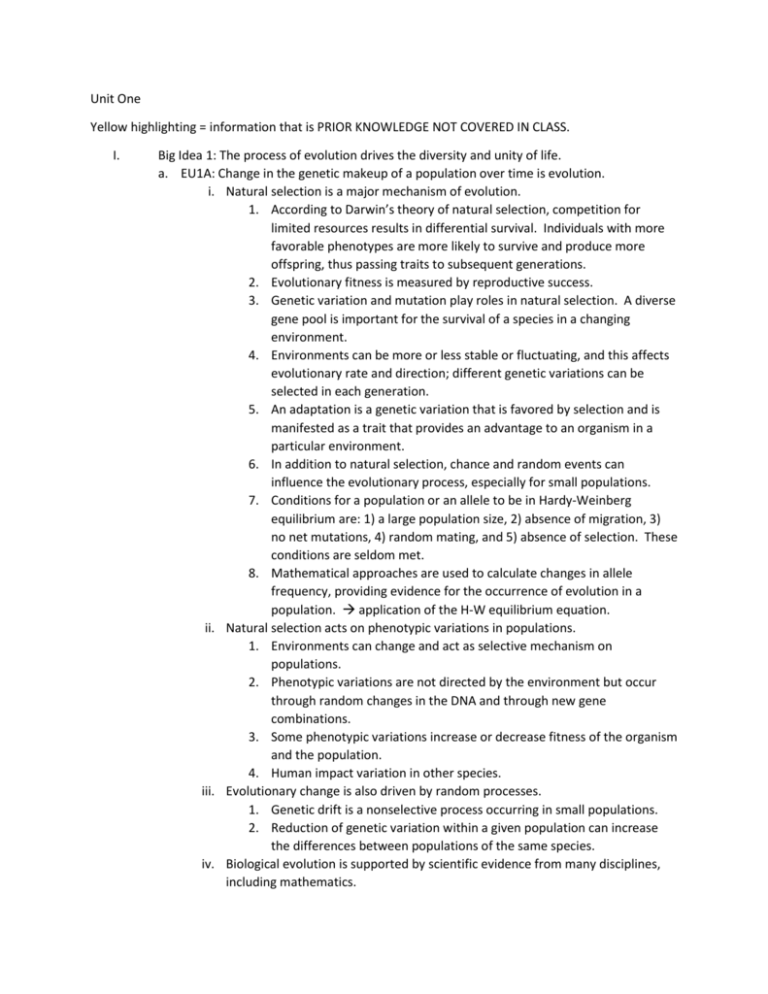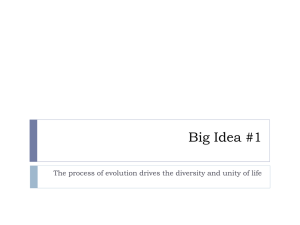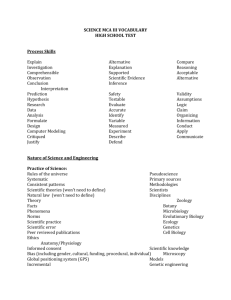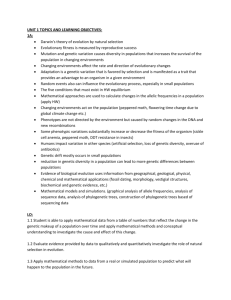Unit Curriculum
advertisement

Unit One Yellow highlighting = information that is PRIOR KNOWLEDGE NOT COVERED IN CLASS. I. Big Idea 1: The process of evolution drives the diversity and unity of life. a. EU1A: Change in the genetic makeup of a population over time is evolution. i. Natural selection is a major mechanism of evolution. 1. According to Darwin’s theory of natural selection, competition for limited resources results in differential survival. Individuals with more favorable phenotypes are more likely to survive and produce more offspring, thus passing traits to subsequent generations. 2. Evolutionary fitness is measured by reproductive success. 3. Genetic variation and mutation play roles in natural selection. A diverse gene pool is important for the survival of a species in a changing environment. 4. Environments can be more or less stable or fluctuating, and this affects evolutionary rate and direction; different genetic variations can be selected in each generation. 5. An adaptation is a genetic variation that is favored by selection and is manifested as a trait that provides an advantage to an organism in a particular environment. 6. In addition to natural selection, chance and random events can influence the evolutionary process, especially for small populations. 7. Conditions for a population or an allele to be in Hardy-Weinberg equilibrium are: 1) a large population size, 2) absence of migration, 3) no net mutations, 4) random mating, and 5) absence of selection. These conditions are seldom met. 8. Mathematical approaches are used to calculate changes in allele frequency, providing evidence for the occurrence of evolution in a population. application of the H-W equilibrium equation. ii. Natural selection acts on phenotypic variations in populations. 1. Environments can change and act as selective mechanism on populations. 2. Phenotypic variations are not directed by the environment but occur through random changes in the DNA and through new gene combinations. 3. Some phenotypic variations increase or decrease fitness of the organism and the population. 4. Human impact variation in other species. iii. Evolutionary change is also driven by random processes. 1. Genetic drift is a nonselective process occurring in small populations. 2. Reduction of genetic variation within a given population can increase the differences between populations of the same species. iv. Biological evolution is supported by scientific evidence from many disciplines, including mathematics. 1. Scientific evidence of biological evolution uses information from geographical, geological, physical, chemical, and mathematical applications. 2. Molecular, morphological and genetic information of existing and extinct organisms add to our understanding of evolution. 3. Fossils can be dated by a variety of methods that provide evidence for evolution. These include the age of rocks where a fossil is found, the rate of decay of isotopes including carbon-14, the relationships within phylogenetic trees, and the mathematical calculations that take into account information from chemical properties and/or geographical data. 4. Morphological homologies represent features shared by common ancestry. Vestigial structures are remnants of functional structures, which can be compared to fossils and provide evidence for evolution. 5. Biochemical and genetic similarities, in particular DNA and nucleotide and protein sequences, provide evidence for evolution and ancestry. 6. Mathematical models and simulations can be used to illustrate and support evolutionary concepts. graphical analysis of allele frequencies, construction of phylogenetic trees based on sequence data b. EU1B: Organisms are linked by lines of descent from common ancestry. i. Organisms share many conserved core processes and features that evolved and are widely distributed among organisms today. ii. Phylogenetic trees and cladograms are graphical representations (models) of evolutionary history that can be tested. 1. Phylogenetic trees and cladograms can represent traits that are either derived or lost due to evolution. 2. Phylogenetic trees and cladograms illustrate speciation that has occurred, in that relatedness of any two groups on the tree is shown by how recently two groups had a common ancestor. 3. Phylogenetic trees and cladograms can be constructed from morphological similarities of living or fossil species, and from DNA and protein sequence similarities, by employing computer programs that have sophisticated ways of measuring and representing relatedness among organisms. 4. Phylogenetic trees and cladograms are dynamic (constantly being revised), based on the biological data used, new mathematical and computational ideas, and current and emerging knowledge. c. EU1C: Life continues to evolve within a changing environment i. Speciation and extinction have occurred throughout the Earth’s history. 1. Speciation rates can vary, especially when adaptive radiation occurs when new habitats become available. 2. Species extinction rates are rapid at times of ecological stress. ii. Speciation may occur when two populations become reproductively isolated from each other. 1. Speciation results in diversity of life forms. Species can be physically separated by a geographic barrier such as an ocean or a mountain range, or various pre- and post-zygotic mechanisms can maintain reproductive isolation and prevent gene flow. 2. New species arise from reproductive isolation over time, which can involve scales of hundreds of thousands or even millions of years, or speciation can occur rapidly through mechanisms such as polyploidy in plants. iii. Populations of organisms continue to evolve. 1. Scientific evidence supports the idea that evolution has occurred in all species. 2. Scientific evidence supports the idea that evolution continues to occur. chemical resistance, emergent diseases, observed directional phenotypic change in a population (finches!) d. EU1D: The origin of living systems is explained by natural processes II. Big Idea 2: Biological systems utilize free energy and molecular building blocks to grow, to reproduce, and to maintain dynamic homeostasis. a. EU2D: Growth and dynamic homeostasis of a biological system are influenced by changes in the system’s environment. i. All biological systems from cells and organisms to populations, communities and ecosystems are affected by complex biotic and abiotic interactions involving exchange of matter and free energy. 1. Organism activities are affected by interactions with biotic and abiotic factors. symbiosis, predator/prey, resource availability 2. The stability of populations, communities, and ecosystems is affected by interactions with biotic and abiotic factors resource availability, food chains/webs, population density ii. Homeostatic mechanisms reflect both common ancestry and divergence due to adaptation in different environments. 1. Continuity of homeostatic mechanisms reflects common ancestry, while changes may occur in response to different environmental conditions. 2. Organisms have various mechanisms for obtaining nutrients and eliminating wastes. 3. Homeostatic control systems in species of microbes, plants, and animals support common ancestry. iii. Biological systems are affected by disruptions to their dynamic homeostasis. 1. Disruptions at the molecular and cellular levels affect the health of the organism 2. Disruptions to ecosystems impact the dynamic homeostasis or balance of the ecosystem invasive species, human impact, natural disasters, salinity, water limitation b. EU2E: Many biological processes involved in growth, reproduction, and dynamic homeostasis include temporal regulation and coordination. * i. Timing and coordination of behavior are regulated by various mechanisms and are important in natural selection. 1. Individuals can act on information and communicate it to others. 2. Responses to information and communication of information are vital to natural selection. (very broad examples p.45) III. Big Idea 3: Living systems store, retrieve, transmit and respond to information essential to life processes. a. Heritable information provides for continuity of life. i. DNA, and in some cases RNA, is the primary source of heritable information. 1. Genetic information is stored and passed to the subsequent generations through DNA molecules and, in some cases, RNA molecules. ii. In eukaryotes, heritable information is passed to the next generation via processes that include the cell cycle and mitosis or meiosis plus fertilization. 1. Meiosis, a reduction division, followed by fertilization ensures genetic diversity in sexually reproducing organisms. iii. The chromosomal basis of inheritance provides an understanding of the pattern of passage (transmission) of genes from parent to offspring. b. Expression of genetic information c. The processing of genetic information is imperfect and is a source of genetic variation. i. Changes in genotype can result in changes in phenotype. 1. Alterations in a DNA sequence can lead to changes in the type or amount of the protein produced and the consequent phenotype. 2. DNA mutations can be positive, negative, or neutral based on the effect or the lack of effect they have on the resulting nucleic acid or protein and the phenotypes that are conferred by the protein. 3. Errors in meiosis can result in changes in phenotype. 4. Changes in chromosome number often result in new phenotypes, including sterility caused by triploidy and increased vigor of other polyploids. 5. Changes in genotype may affect phenotypes that are subject to natural selection. Genetic changes that enhance survival and reproduction can be selected by environmental conditions. antibiotic resistance, pesticide resistance, sickle cell disorder 6. Selection results in evolutionary change ii. Biological systems have multiple processes that increase genetic variation. 1. Sexual reproduction in eukaryotes involving gamete formation, including crossing-over during meiosis and the random assortment of chromosomes during meiosis, and fertilization serve to increase variation. Reproduction processes that increase genetic variation are evolutionarily conserved and are shared by various organisms. iii. Viral replication results in genetic variation, and viral infection can introduce genetic variation into the hosts. d. Cells communicate e. Transmission of information IV. Big Idea 4: Biological systems interact, and these systems and their interactions possess complex properties. a. Interactions within biological systems lead to complex properties. i. Communities are composed of populations of organisms that interact in complex ways. ii. Interactions among living systems and with their environment result in the movement of matter and energy. 1. Human activities impact ecosystems on local, regional, and global scales. a. As human populations have increased in numbers, their impact on habitats for other species have been magnified. b. In turn, this has often reduced the population size of the affected species and resulted in habitat destruction and, in some cases, the extinction of species. 2. Many adaptations of organisms are related to obtaining and using energy and matter in a particular environment. b. Competition and cooperation are important aspects of biological systems. i. Interactions between and within populations influence patterns of distribution and abundance. 1. Species-specific and environmental catastrophes, geological events, the sudden influx/depletion of abiotic resources or increased human activities affect species distribution and abundance. loss of keystone, invasives ii. Distribution of local and global ecosystems change over time. a. Human impact accelerates change at local and global levels i. Logging, slash and burn agriculture, urbanization, monocropping, infrastructure development, global climate change threaten ecosystems and life on Earth ii. An introduced species can exploit a new niche free of predators or competitors, thus exploiting new resources iii. Introduction of new diseases can devastate native species b. Geologic and meterologic events impact ecosystem distribution continental drift, meteor impact, el nino c. Naturally occurring diversity among and between components within biological systems affects interactions with the environment. i. Variations in molecular units provides cells with a wider range of functions. 1. Multiple copies of alleles or genes may provide new phenotypes. a. A heterozygote may be more a advantageous genotype than a homozygote under particular conditions (SICKLE CELL ANEMIA AND MALARIA), since with two different alleles, the organism has two forms of proteins that may provide functional resilience in response to environmental stresses ii. Environmental factors influence the expression of genotype in an organism. iii. The level of variation in a population affects population dynamics. 1. Population ability to respond to changes in the environment is affected by genetic diversity. Species and populations with little genetic diversity are at risk for extinction. potato blight, California condors, blackfooted ferrets 2. Genetic diversity allows individuals in a population to respond differently to the same changes in environmental conditions. a. Not all individuals in a population disease outbreak are equally affected. 3. Allelic variation within a population can be modeled by the HardyWeinberg equation. iv. The diversity of species within an ecosystem may influence the stability of the ecosystem. 1. Natural and artificial ecosystems with fewer component parts and with little diversity among the parts are often less resilient to changes in the environment. 2. Keystone species, producers, and essential abiotic and biotic factors contribute to maintaining the diversity of an ecosystem. The effects of keystone species on the ecosystem are disproportionate relative to their abundance in the ecosystem, and when they are removed from the ecosystem, the ecosystem often collapses.









